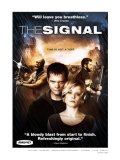We’re all familiar with the zombie movie, most particularly the post-1968 zombie flick. That was the year George Romero permanently transformed the zombie into a flesh-eating ghoul – perhaps the only instance of a long-standing monster having its rules of behaviour altered almost beyond recognition, and to the point that there have been virtually no NON-flesh-eating zombies on film since Night of the Living Dead. But that’s a topic for another time. Co-existing with the neo-zombie movie, and sometimes fusing with it (as in 28 Days Later and its sequel), is the tale of mass psychosis. A recent example is the 2007 film The Signal, directed by David Bruckner, Jacob Gentry and Dan Bush.
In the nondescript city of Terminus (no doubt twinned with Racoon City), a strange signal is broadcast across all media. It has the effect of turning anyone who watches it into a murderous loon. Chaos descends quickly as one might imagine. The film is structured as three semi-distinct but overlapping stories (not entirely unlike Pulp Fiction, as has been pointed out elsewhere, though The Signal is far more linear than Tarantino’s movie). In the first, Anessa Ramsey leaves the home of her lover (Justin Welborn) to find her husband (A.J. Bowen) descending into the signal’s embrace. In the maelstrom of violence that erupts, she ultimately flees the apartment, unable to trust anyone. The second story is Bowen’s, as he tries to find his wife, and falls in with two other people in various stages of signal-mesmerism. This segment, often blackly funny, shows us the behaviour of the psychotics from their own perspective, and drives home the fact that they believe their actions to be entirely rational. In the third story, we track Welborn’s struggle with Bowen as he tries to find and rescue Ramsey.
The film has, of course, been compared to Stephen King’s Cell, and there has been some effort to point out that the film precedes the book. But this is something of a red herring, since neither tale was the first of this sort of narrative. There is Romero’s own The Crazies (1973), but even closer is James Herbert’s novel The Fog (1975). Here, the menace is the titular chemical cloud, but its effect – mass homicidal mania – is much like that seen in The Signal. But for all this, the film is very much its own beast, and a rather downbeat, disturbing one at that. The violence is appalling in its brutality, which is as it should be, given the story being told. What makes the carnage harder to take is the distinctly humorous moments, especially in the second act. The humour does not, however, have the effect of diluting the horror, as it so often does. Instead, the eruptions of violence are all the more distressing, because we can’t believe the movie is going to be so nasty after being so witty. Furthermore, the performances, writing and characterization are of an order that one is not used to with this kind of nastiness (the combo is not unheard of, naturally, but it is still rather rare). And while I could have done without a few of the flashbacks that fill in blanks the audience has already probably filled in for itself, the net result is both punishing and thought-provoking.
And this last point is also as things should be. These stories of total societal breakdown invite us to gaze into the abyss our veneer of civilization so thinly covers, and the smart films (of which this is one) speak clearly to the anxieties of their times.
A film worth seeing, flinching at, and mulling over.


